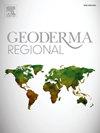生物炭和堆肥及其相互作用对撒哈拉沙质土壤碳氮矿化的影响
IF 3.3
2区 农林科学
Q2 SOIL SCIENCE
引用次数: 0
摘要
由于生物炭和堆肥的互补性,结合高碳(C)固存潜力和养分投入,它们在农业土壤中的共施越来越受到关注。在突尼斯南部的绿洲取样了一个有机枯竭的沙质土壤,评估了以枣棕榈为基础的生物炭和堆肥作为土壤改良剂的影响,并评估了这些有机产品单独或混合使用的生物降解性。在112 d内监测了未加生物炭和/或堆肥的土壤碳氮矿化动态。在开始和培养56天和112天后采集土壤样品,使用Rock-Eval®热分析对土壤有机质进行定量和表征。112 d后,堆肥的表观矿化有机碳分数≈16.7%。对C矿化数据进行模型拟合,得到单一堆肥和生物炭不稳定组分的矿化速率常数分别为0.012和0.037 d−1。它们的顽固性组分在堆肥和生物炭中所占的比例分别为初始C的77%和98%。单独产物与混合产物的模型拟合比较没有差异,表明混合产物中生物炭和堆肥对碳矿化没有显著的相互作用。然而,与单独施用相同产品的土壤相比,使用预孵育的生物炭-堆肥混合物进行土壤改良的累积二氧化碳排放量较低。在施用≈77 t.ha−1的枣椰树堆肥的土壤中,堆肥的短期氮供应估计为53±28 kg N.ha−1。与未处理的土壤相比,生物炭与堆肥预孵育使土壤氮供应量增加到106±45 kg N.ha−1。初始纯堆肥的低热稳定性突出了堆肥过程中有机物的低稳定性。堆肥的高含盐量似乎并不能抑制含盐非碱土中有机物的分解。然而,为了优化其碳稳定性,避免干旱地区土壤和水的盐碱化,需要改进椰枣渣堆肥工艺。本文章由计算机程序翻译,如有差异,请以英文原文为准。
Influence of biochar and compost and their interaction on carbon and nitrogen mineralization in a Saharan sandy soil
Biochar and compost co-application in agricultural soils is of growing interest due to their complementary nature, combining high carbon (C) sequestration potential and nutrient inputs. An organically depleted sandy soil sampled in an oasis in southern Tunisia was selected to evaluate the impact of date palm-based biochar and compost as soil amendments and to assess the biodegradability of these organic products sole or in mixtures. Carbon and Nitrogen (N) mineralization dynamics in soils amended or not with biochar and/or compost were monitored during 112 days. Soil samples were taken at the start and after 56 and 112 days of incubation for soil organic matter quantification and characterization using Rock-Eval® thermal analysis.
The apparent mineralized organic carbon fraction of the compost was ≈16.7 % after 112 days. The mineralization rate constants of the labile fractions of sole compost and biochar were 0.012 and 0.037 day−1 respectively following model fittings on C mineralization data. The proportion of their recalcitrant fractions were 77 and 98 % of initial C for compost and biochar, respectively. The comparison of model fits obtained for products alone vs mixtures showed no differences, suggesting no significant interaction between biochar and compost in mixtures on C mineralization. However, in the soil amended with pre-incubated biochar-compost mixtures, lower cumulated CO2 emissions were found compared with the same products inputs applied individually. The nitrogen supply of the compost was estimated at 53 ± 28 kg N.ha−1 in the short-term in the soil amended with ≈77 t.ha−1 of date palm compost. Biochar pre-incubated with compost increased the soil N supply to 106 ± 45 kg N.ha−1 compared with the unamended soil.
The low thermal stability of the initial pure compost highlighted the low stabilization of the organic matter during the composting process. The high salt content of the compost does not seem to inhibit organic matter decomposition in a saline non-sodic soil. However, improving the composting process with date palm residues is needed to optimise its carbon stability, and to avoid salinization of the soil and water in arid areas.
求助全文
通过发布文献求助,成功后即可免费获取论文全文。
去求助
来源期刊

Geoderma Regional
Agricultural and Biological Sciences-Soil Science
CiteScore
6.10
自引率
7.30%
发文量
122
审稿时长
76 days
期刊介绍:
Global issues require studies and solutions on national and regional levels. Geoderma Regional focuses on studies that increase understanding and advance our scientific knowledge of soils in all regions of the world. The journal embraces every aspect of soil science and welcomes reviews of regional progress.
 求助内容:
求助内容: 应助结果提醒方式:
应助结果提醒方式:


